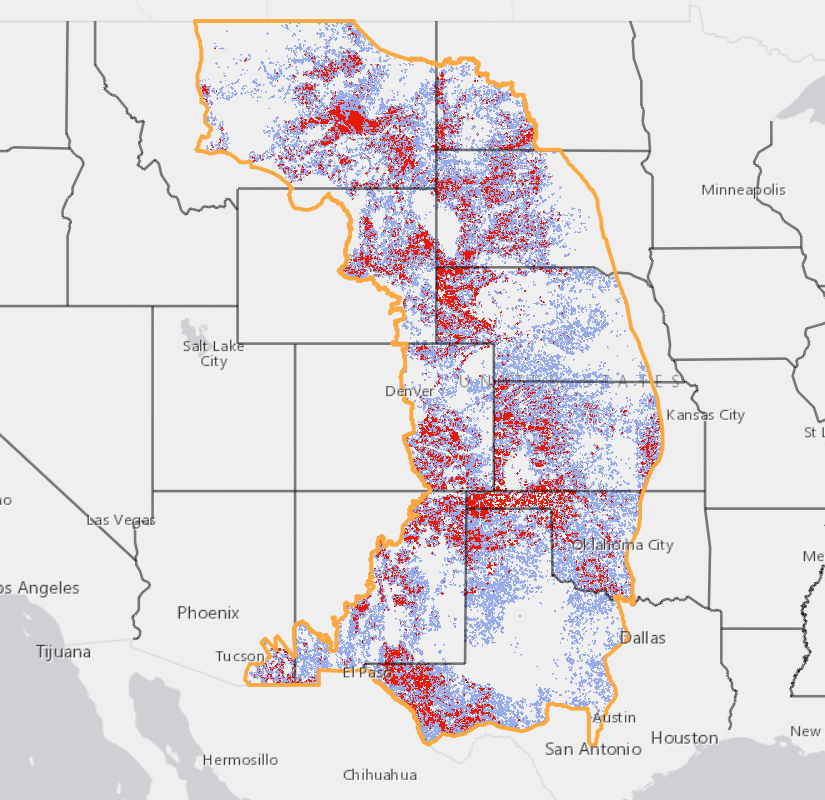Prairie Dog

WESTERN GRASSLAND SPECIES:
Black-Tailed Prairie Dog (Cynomys ludovicianus)
White-Tailed Prairie Dog (Cynomys leucurus)
Gunnison’s Prairie Dog (Cynomys gunnisoni)
Utah Prairie Dog (Cynomys parvidens)
Photo Credit – Craig Bihrle
Black-tailed Prairie Dog Habitat Modeling

The WAFWA Grassland Initiative in association with the Home on the Range project (Homes on the Range (HOTR) – Colorado Natural Heritage Program) has developed a large-scale collaborative conservation planning initiative for the black-tailed prairie dog (BTPD) ecosystem that stretches across North America’s central grasslands. Because prairie dogs are keystone species their conservation and management often lies at the core of grassland conservation efforts. Through spatial modelling, we have identified potential landscapes for prairie dog ecosystem conservation that consider ecological, political, and social factors, along with changing climate and land use to maximize long-term conservation potential and co-existence with human activities. Our project results and data available for download, below, include two components: 1) a BTPD habitat suitability model under both current climate and projected future climate and 2) priority landscapes for BTPD ecosystem conservation across the range of BTPDs within the United States.
2022 KEYSTONE SPECIES HABITAT SUITABILITY MODEL (PART 1)
Final Report: Keystone Species Habitat Suitability Model (Part 1)
The capacity for a landscape to support spatially extensive grassland conservation efforts depends on a complex suite of abiotic, ecological, social, and economic factors. Mapping of landscape capacity to support such conservation efforts in the central Great Plains can provide a much-needed tool for optimizing use of scarce funds for grassland conservation and restoration efforts. This is especially valuable for contemporary management because of the social, environmental, and economic factors that influence where prairie dog complexes can be conserved and expanded across large blocks of continuous habitat – to support numerous grassland species.
To address this need, we are working to identify potential landscapes for conservation, through spatial modeling. Our work is examining ecological, political, and social factors, along with changing climate and land use to maximize long-term conservation potential and co-existence with human activities. Our project involves two major components: Part I, developing a black-tailed prairie dog habitat suitability model (HSM) under both current climate and projected future climate scenarios (Fig. 2) and Part II, identifying suitable landscapes for black-tailed prairie dog (BTPD) ecosystem conservation using the conservation planning tool, Zonation. Here we provide the Final Report for the BTPD HSM (Part I)
White-Tailed Prairie Dog & Gunnison’s Prairie Dog
Conservation Strategy & Conservation Assessments (2006)
White-Tailed Prairie Dog & Gunnison’s Prairie Dog Conservation Strategy
In 2006, WAFWA established a Memorandum of Understanding for the Conservation and Management of Species of Conservation Concern Associated with Prairie Ecosystems (MOU) and completed an assessment for the White-Tailed Prairie Dog (WTPD) & Gunnison’s Prairie Dog (GPD) along with development of a companion conservation strategy for both species.
Black-Tailed Prairie Dog
Multi-State Conservation Plan (2002)
A Multi-State Conservation Plan For The Black-tailed Prairie Dog
A Multi-State Conservation Plan for the Black-tailed Prairie Dog, Cynomys ludovicianus, in the United States. Providing an addendum to the Black-tailed Prairie Dog Conservation Assessment and Strategy of November 3, 1999 (provided below).
Background
1998. Several non-governmental organizations petitioned the U.S. Fish and Wildlife Service (USFWS) requesting that the black-tailed prairie dog (BTPD; Cynomys ludovicianus) be listed as a threatened species under the Endangered Species Act. That same year, 9 of 11 States that were within the historical range of BTPD began conservation efforts by forming the Interstate Black-tailed Prairie Dog Conservation Team (BTPDCT).
1999. A conservation plan was finalized that established conservation objectives for the species, which included establishing a conservation team, drafting State specific management plans, the identification of focus areas for conservation, and a commitment to monitor the BTPD population.
2000. The USFWS issued a finding of “warranted but precluded” and the States continued to work on conservation measures.
2002. With the filing of the white-tailed prairie dog petition, the Black-tailed Prairie Dog Conservation Team was expanded to all prairie dogs species, and the States began to work on all the species in earnest.
2003. The BTPDCT published an addendum to the 1999 BTPD Conservation Assessment and Strategy, entitled, “A Multi-State Conservation Plan for the Black-tailed Prairie Dog, Cynomys ludovicianus, in the United States.” The goal of the national, and associated State management plans, was to remove enough threats to the BTPD that long-term conservation of the species will be assured through State management.
2004. The BTPD was removed from the ESA candidate list. However, pending litigation for the all prairie dog species stills occurs today.
2006. Establishment of the WAFWA Memorandum of Understanding for the Conservation and Management of Species of Conservation Concern Associated with Prairie Ecosystems (MOU) and WAFWA completed an assessment for the WTPD and GPD along with development of a companion conservation strategy for both species.
Prairie Dog Conservation Team
By developing partnerships, identifying priorities, and implementing conservation actions simultaneously across the landscape for habitats and wildlife, WAFWA and their partners believe they will have a much better chance of maintaining grassland ecosystems. Conservation measures from this grant will be delivered through the various WAFWA work groups and the partnerships they have established with U.S. Fish and Wildlife Service (USFWS), U.S. Forest Service, Bureau of Land Management, National Park Service, USDA Wildlife Service, nongovernmental entities, and private landowners at the county and local level.
- 2008 Annual Summary for USFWS (PDF, 354 KB)
- 2009 WTPD Annual Summary for USFWS (PDF, 52 KB)
- 2009 BTPD Annual Summary for USFWS (PDF, 448 KB)
- 2010 Annual Summary for USFWS (PDF, 389 KB)
- 2011 Annual Summary for USFWS (PDF, 497 KB)
- 2012 Annual Summary for USFWS (PDF, 2 MB)
- 2013 Annual Summary for USFWS (PDF, 648 KB)
- 2014 Annual Summary for USFWS (PDF, 72 KB)